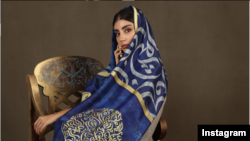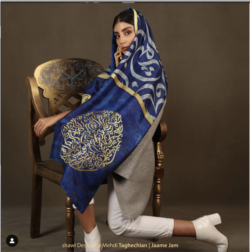"We should not forget that the fashion and clothing market is dominated by underground designers and producers," an Iranian official in charge of "supervising and controlling fashion and clothing" admitted in an interview with an Iranian news agency (ILNA) on Saturday.
The lady is also responsible for the Fajr Fashion and Clothing Festival, one of the several festivals to celebrate the 41st anniversary of the Islamic Revolution, next week.
What Ms. Marzieh Shafapour admitted is the truth and the whole truth. Four decades after an Islamic Revolution which aimed to create an alternative to the western culture and fashion among other things, the Islamic Republic has gravely failed.
The way Iranians, particularly women, dress is usually a big surprise to foreigners visiting the country who usually expect to see black-veiled women who are seen in photos and on western channels marching in official rallies.
But many Iranian women simply follow the minimum Islamic dress code, meaning a headscarf and a tunic or coat called manteaux. It's compulsory and defying it is punishable by law.
Ingenious designers, and fashionable women, however, always find ways to twist the compulsory headscarf and tunic into fashion statements rather than a statement of faith or belief in the ideals of the Islamic Revolution, always pushing the boundaries further and further.
In the past ten years or so, with the advent of social media that allowed underground designers to showcase their creations and share them with others, underground fashion has experienced a boom.
Amid internet censorship by throngs of government cyber-censors, many worked their way through proxy servers and VPNs to post professionally-taken photos of models donning their creations on Instagram and Telegram, and sell them to the fashion-hungry.
The Islamic Republic now had to fight its war against fashion-savvy women and men on several fronts, on social media, on the streets, with modeling agencies they said promoted vulgarity, with underground boutiques and private fashion shows.
In March last year the police raided a fashion show in Lavasan, a posh mountainous area near Tehran dotted with villas nestled in fruit orchards, and arrested everyone. The female models wore head covers and their clothes were not revealing at all, but they wore wings.
Conservative websites said the designs resembled those of "Satan-worshipers". Needless to say, both organizers and participants got into serious trouble with the law for "promoting immorality".
A sneaky video of a fashion show that was aborted by the morality police.
Things haven't stopped there for the Islamic establishment. Since 2017 a campaign against forced dress code, founded by Masih Alinejad has been driving the hardliner religious and political establishment up the walls. Women who joined the campaign would drop their headscarves in public places, take selfies or videos and publish them online. Iranian security forces now tired of fighting women on the streets are hunting for campaign activists. Several of them are now in prison.
In the 80s and 90s defying the dress code meant wearing short tunics or colorful scarves and letting a few strands of hair hang out from under it, now it is quite the norm. Defying hijab used to be punished by arrests at the hands of the morality police, facing trial, being sentenced to prison, fined or even lashed.
In the summer of 1989 I went through the arrest, trial and lashes myself for wearing a colorful scarf and tunic, make-up and letting my hair show from under the tiny scarf. Women like me were called "bad hijab" which means a woman who is not properly observant of the Islamic dress code.
My look was pretty tame compared with the way many women in Iran dress now, my tunic came down to my knees and at least had buttons in the front, but the judge who summarily tried tens of women on that hot summer day meted out six lashes to me. He was lenient toward me because I was just married, others got many more lashes.









